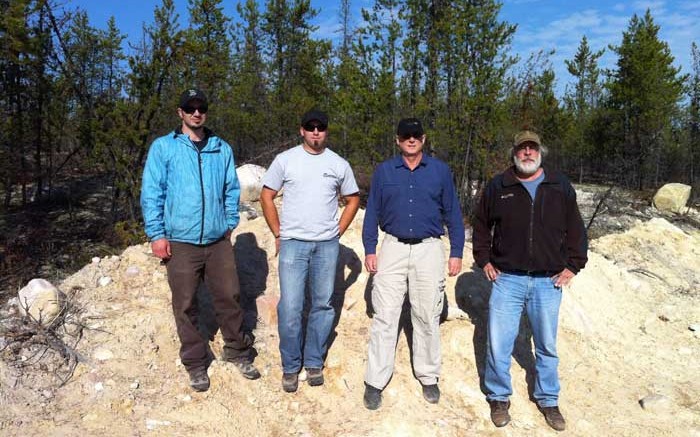Denison Mines (TSX: DML; NYSE-Arca: DNN) owns a 60% stake in the Wheeler River uranium project that lies between Cameco’s (TSX: CCO; NYSE: CCJ) Key Lake mill — the world’s largest high-grade uranium mill — and its McArthur River mine, and several analysts believe the junior exploration and development company could become a takeover target in the uranium sector. Cameco already owns 30% of Wheeler River, with JCU (Canada) Exploration Co. holding the remaining 10%.
“Denison is an attractive target for companies looking to either gain critical mass in [Rio Tinto], or establish a stranglehold on the Athabasca basin [Cameco],” Cantor Fitzgerald analyst Rob Chang wrote in a June 3 research report, marking the initiation of his coverage of the company. “Based on the sum of its current resource estimates, Denison is trading at a significant discount to recent transactions of its Athabasca-focused peers” — namely Hathor Exploration & Fission Energy.
“When Rio Tinto entered the basin by acquiring Hathor Exploration’s Roughrider project in 2011, it sparked a bidding war with Cameco, which led to four sequentially higher offers for the Roughrider asset,” Chang continues. “It is conceivable that Cameco and Rio Tinto may once again spar over further quality assets in the basin. Moreover, a foreign heavyweight — such as AREVA or KEPCO — may look to expand its presence as well.”
Since Chang published this note, Denison has reported results from the initial four drill holes of a planned 23-hole summer drill program. Intercepts from three holes drilled into the A zone of the project’s high-grade Phoenix deposit included 43.2% eU308 over 10.3 metres from a 410.4-metre depth in hole 525; 16.4% eU308 over 1.7 metres from a 405.4-metre depth in hole 526; and 13% eU308 over 3.1 metres from a 403.7-metre depth in hole 527. (The term eU308 refers to radiometric-equivalent uranium oxide calculated from a total gamma downhole probe.)
Like Chang, Colin Healey and Alan Spence of Haywood Securities believe Denison could loom large on the radar of some of the larger uranium players. “The latest round of drill results highlight the potential for resource expansion at Wheeler River, particularly at Phoenix Zone A,” they write in a July 24 note. “We continue to view Wheeler River as one of the most attractive exploration- and development-stage assets in the Athabasca basin, and an integral part of our thesis that Denison’s strategic asset base makes it an attractive acquisition candidate . . . [the] results add to that potential.”
The company says that results from hole 525, which was drilled along the western margin of the Phoenix A deposit, may result in more holes being punched into that part of the deposit in the coming weeks. Calling the hole a “stellar result,” David Sadowski of Raymond James says in a note that “this mind-boggling rock value reminds us of how powerful the mineralizing system at Wheeler is, but . . . also speaks to the resource growth possible with greater drill density along the margins, and as stepouts from high-grade zones at Phoenix A and B.”
Wheeler River’s Phoenix deposits in the Eastern Athabasca basin of northern Saskatchewan are 600 km north of Saskatoon, 260 km north of La Ronge and 110 km southwest of Points North Landing. Phoenix consists of the Phoenix A and Phoenix B zones, 400 metres below surface within a 1 km, northeast-trending mineralized corridor.
Both deposits contain a high-grade core within a low-grade mineralized envelope, and extend southeastward from the WS fault along the unconformity. Some mineralization also occurs on the northwest side of the WS Fault, a regional fault zone, but commonly at a lower elevation, according to a technical report completed at the end of last year, while other uranium mineralization occurs in basement rocks below and adjacent to the Phoenix deposits.
Indicated resources of the A and B deposits, at a cut-off grade of 0.8% uranium oxide (U3O8), stand at 152,400 tonnes grading 15.6% U3O8 for 52.3 million contained lb. U3O8. Inferred resources add 11,600 tonnes averaging 29.8% U3O8 for 7.6 million contained lb. U3O8.
The company says that deposits with “incredible grades” like Phoenix “are rare in nature and have only been documented in two other locations — McArthur River and Cigar Lake.”
Phoenix was discovered in 2008 in the hangingwall of a rock unit termed “quartzite,” which is known to extend over more than 18 km on the Wheeler River property.
Over the last year Denison has gone from being a U.S.-focused uranium producer to an Athabasca-focused uranium explorer. Including Wheeler River, the company’s exploration project portfolio includes 50 projects in the basin totalling more than 6,580 sq. km. The company holds a 22.5% stake in the McClean Lake joint-venture project, which contains several uranium deposits and the McClean Lake uranium mill, which is 750 km north of Saskatoon and one of the world’s largest uranium-processing facilities. Denison also owns 25.17% of the Midwest project and 60% of the Waterbury Lake project, which is close to Rio Tinto’s (NYSE: RIO; LSE: RIO) Roughrider deposit.
Outside of Canada, Denison owns 100% of the conventional heap-leach Mutanga project in Zambia, and an 85% stake in the in-situ recovery projects held by the Gurvan Saihan joint venture, 400 km southwest of the Mongolian capital of Ulaanbaatar. It also owns 51% of the Dome project in Namibia, within 100 km of Rio Tinto’s Rossing mine and Paladin Energy’s (TSX: PDN) Langer Heinrich mine.
At press time Denison was trading at $1.38 per share within a 52-week range of $1.04 to 1.68. The company has 450 million shares outstanding. Chang of Cantor Fitzgerald has a $1.60-per-share target price on the stock, and Edward Sterck of BMO Capital Markets has a target price of $1.50 per share.


Be the first to comment on "Wheeler River wins more converts for Denison"